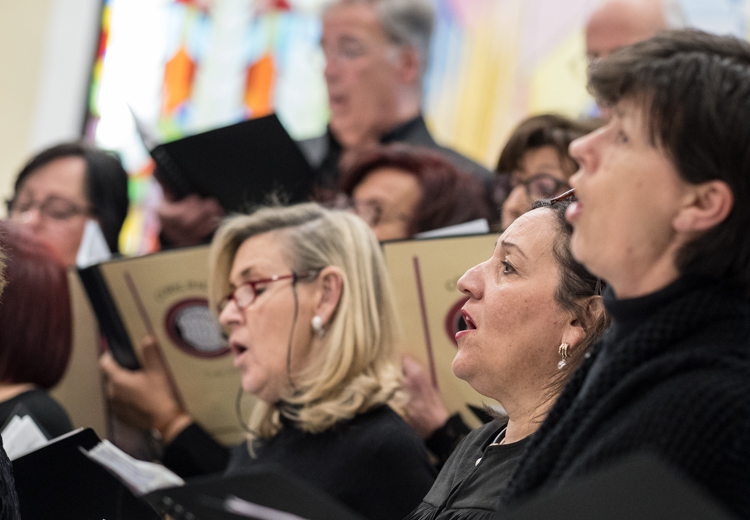The main theme in this blog is the town of Calpe, about 50 km north of Alicante. The choir of the European School of Alicante in which my wife sings had an Easter performance there. Trying to be a good husband, I went along with my wife, even though religious music is not exactly my cup of tea. But in the end I was pleased with the outing–lots of photos, and an interesting church to visit.
13_1
My wife had to be there about 1 1/2 hour before the performance, so I had time to explore the town. Calpe is located on the Mediterranean coast and is a popular destination for German visitors and part-time residents (they even have an Oktoberfest every autumn). But the centre of the town is typical small-town Spain:

13_2
A mural depicting historical scenes:

13_3
Another street in the centre:

13_4
As is often the case in small towns in Spain, the church is located on the highest point of the town, so people have to climb rather steep streets to get there:

13_5
I came across this lovely place where one can sit down and rest for a minute:

13_6

13_7
Along the main pedestrian street, there are literary inscriptions on the pavement in various languages, here in German:

13_8
After walking around for an hour or so, I stopped for some sustenance at La Fregata bar:

13_9
And then it was time to go to the church, Parroquia de Nuestra Señora de las Nieves:

13_10
The church is modern, completed in 1997, incorporating the original 15th century church on the same site. This is the main altar:

13_11
La Virgen de las Nieves:

13_12
A moment of reflection:

13_13
The church had prepared the figures for the Semana Santa processions. This is Jesús de los Gitanos (Jesus of the Gypsies):

13_14
Virgen de los Dolores (Our Lady of Sorrows):

13_15
Like most towns on the coast, Calpe these days lives mainly off tourism, but the roots of the town are in fishing, and it is still part of the local identity. This is reflected in the frescos in the church:

13_16

13_17
Then it was time for the choral performance in which my wife participated. It was actually two choirs, my wife’s European School of Alicante parents choir, and a local Calpe one. Both have the same artistic director, a lady originally from Cuba. Here she gets things started:

13_18
My wife in action (she is the one in focus, of course):

13_19
The conductor, again. I like to photograph her because the really gets into the music and has an expressive face:

13_20
Most of the members of the two choirs were women, but there were a few male voices in the Calpe choir:

13_21
After the performance, while waiting for my wife to finish chatting and saying goodbye to the other singers, I wandered around the church some more. I was amused to see this poster–a sign of the times:

13_22
And a dark piece of history. Francisco Sedra Ivars was the priest of the Calpe church who was executed by the Republican forces in 1936, at the beginning of the Spanish Civil War. While most of the killings during the war were carried out by Franco’s fascists, atrocities were committed by both sides, with members of the clergy (as well as nuns and monks) frequent targets for extremists on the Republican side. He was beatified by Pope John Paul II in 2001:

The next few images are from my usual outings on bicycle.
13_23
The plaza in Aigües, full of people for once–it is Palm Sunday, the start of the Holy Week, and people go to church–at least some do, while others go to the bars in front of the church:

13_24
The children skip the service too, they play on the church steps instead:

13_25
Political graffiti in El Campello. The text reads, “study for a career as a slave”:

13_26
A sure sign that spring and thus the beach season are here. The chiringuitos are back on the beaches of El Campello:

13_27
Field of greens on the way to Jijona:

13_28
Announcement board outside a Jijona municipal office, a nice snapshot of small town life. The board gives information about the operating hours of the local “ecoparc”, i.e. a place where you bring stuff for recycling and proper disposal; a municipal campaign to capture, sterilise and release stray cats (so as to control the population in a humane way) is looking for volunteers; there is a reminder that the annual motor vehicle tax payment is coming due, etc. Most of the announcements are in the local dialect Valenciano rather than standard Spanish (Castellano):

13_29
Fountain along the main street of El Campello. We have had occasional strong wind, and on more than occasion, I have received an unwanted shower when cycling past it:

Finally, five images from a couple of walkabouts in the centre of Alicante.
13_30
A well-worn façade of a club of dubious repute:

13_31
Garage door:

13_32
Urban life, Plaza Seneca:

13_33
Stand selling chips and snacks, Plaza Calvo Sotelo:

13_34
Good news, apparently, Plaza Calvo Sotelo:
